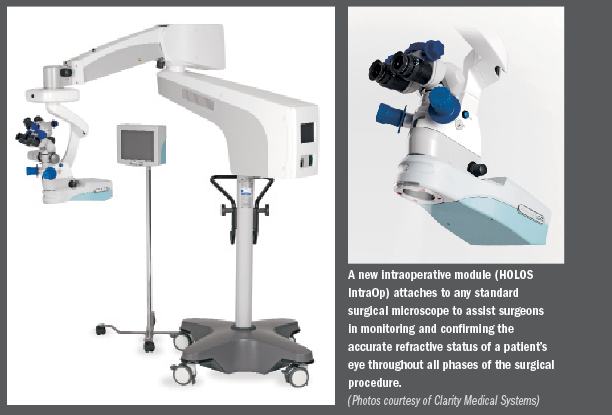Article
Impact of intraoperative aberrometer measurements
Recently unveiled device features video of intraoperative wavefront data that allows cataract surgeons to see continuous real-time refraction changes during surgery.
Take Home
Recently unveiled device features video of intraoperative wavefront data that allows cataract surgeons to see continuous real-time refraction changes during surgery.

Dr. Slade
By Nancy Groves; Reviewed by Stephen Slade, MD, FACS
Houston-Cataract surgeons now have access to another tool that can help them achieve emmetropia in their patients by determining the correct IOL power before implanting the lens-The HOLOS intraoperative aberrometer (HOLOS IntraOp, Clarity Medical Systems).
The new aberometer provides streaming video of intraoperative wavefront data to access continuous real-time refraction changes during cataract surgery.
“Intraoperative aberrometers are devices that measure in the operating room the power of the eye and astigmatism so that you can more accurately predict and then verify the power of the IOL, the power of the astigmatism, and the position of a toric IOL that you put in the eye,” said Stephen Slade, MD, FACS, Slade and Baker Vision Center, Houston. “The whole idea is to prevent lens misses and try to get the patient as accurate a result as possible so that they see as well as possible without glasses after the surgery.”
Dr. Slade used a prototype of the HOLOS IntraOp several times before its release.

Examining HOLOS
The HOLOS is one of two intraoperative aberrometers on the market. The other is the ORA System (WaveTec Vision), which was launched last July.
While the devices have the same purpose, they use different types of aberrometry.
“We’ll have to wait and see which is faster and more user-friendly,” Dr. Slade said, explaining that the HOLOS IntraOp was not yet in physician practices outside of those that had access to prototypes. However, his practice has acquired the ORA System and uses it regularly, so he is familiar with the concept of intraoperative aberrometry.
Having tested the HOLOS IntraOp, Dr. Slade describes it as “very user friendly and very fast. I really liked using it, and it’s got a lot of promise.”
The aberrometer hangs off the surgical microscope, which is something surgeons will have to get used to, he said, although this should be a minor adjustment.
Qualitative and quantitative refractive data is presented in real time on a small screen, where the surgeon can get immediate feedback on how adjustments would affect refraction. All refractive data is synchronized to real-time surgical video of the patient’s eye.
The HOLOS IntraOp also has a built-in DVR that can be used for wavefront data and postoperative review of patient videos.
The concept of intraoperative aberrometry is appealing, Dr. Slade said, especially for premium IOL patients who have high expectations.
He has observed this during more than a year of using the ORA System in his practice.
“There’s a real gap in results between what we get and what we want in cataract patients,” Dr. Slade said. “With LASIK, you’re getting 96% or 97% or better 20/20 uncorrected vision, but with cataract surgery, it’s much less. There’s an unmet need for technology that can help us meet the patients’ expectations.
“No matter how good the lens is or the laser, if you don’t hit the target, nothing else really matters,” he continued. “That’s what this new technology hopes to do.”
Stephen Slade, MD, FACS
P: 713-626-5544
Dr. Slade has no financial interest in the subject matter.
Subscribe to Ophthalmology Times to receive the latest clinical news and updates for ophthalmologists.
Newsletter
Don’t miss out—get Ophthalmology Times updates on the latest clinical advancements and expert interviews, straight to your inbox.





